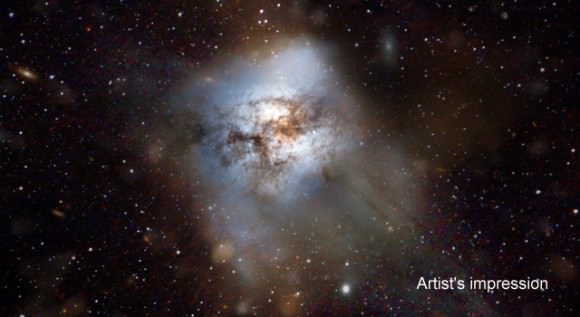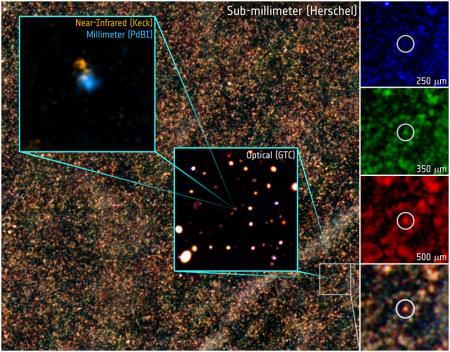Most of the early galaxies that astronomers have been able to observe are small with a low-to-moderate amount of star production. But now the Herschel Space Observatory has found a massive dust-filled galaxy churning out stars at an incredible rate, with all of this taking place back when the cosmos was a just 880 million years old. The galaxy is about as massive as our Milky Way, but produces stars at a rate 2,000 times greater, prompting the researchers to call it a “maximum-starburst” galaxy.
The astronomers involved in its discovery say its mere existence challenges our theories of galaxy evolution.
“Massive, intense starburst galaxies are expected to only appear at later cosmic times,” says Dominik Riechers, currently an assistant professor at Cornell. “Yet, we have discovered this colossal starburst just 880 million years after the Big Bang, when the universe was at little more than 6 percent of its current age. Riechers is the first author of the paper describing the findings in the April 18 issue of the journal Nature.
The prevailing thought on early galaxy and star formation has been that the first galaxies to form were relatively small and lightweight, containing only a few billion times the mass of our Sun. They form their first stars at rates of a few times that experienced by the Milky Way today, and the galaxies would grow by merging with other small galaxies. In theory, galaxies as massive as the newly found galaxy – named HFLS3 — should not be present so soon after the Big Bang.
HFLS3 appears as little more than a faint, red smudge in images from the Herschel Multi-tiered Extragalactic Survey (HerMES).
The extreme distance to HFLS3 means that its light has travelled for almost 13 billion years across space before reaching us. We therefore see it as it existed in the infant Universe, just 880 million years after the Big Bang or at 6.5% of the Universe’s current age.

Even at that young age, HFLS3 was already close to the mass of the Milky Way, with roughly 140 billion times the mass of the Sun in the form of stars and star-forming material. After another 13 billion years, it should have grown to be as big as the most massive galaxies known in the local Universe.
“Looking for the first examples of these massive star factories is like searching for a needle in a haystack; the Herschel dataset is extremely rich,” said Riechers.
Tens of thousands of massive, star-forming galaxies have been detected by Herschel as part of HerMES and sifting through them to find the most interesting ones is a challenge.
“This particular galaxy got our attention because it was bright, and yet very red compared to others like it,” said co-investigator Dave Clements of Imperial College London.
While the discovery of this single galaxy isn’t enough to overturn current theories of galaxy formation, finding more galaxies like this one could challenge those theories, the astronomers say. At the very least, theories will have to be modified to explain how this galaxy formed, Riechers says.
“This galaxy is just one spectacular example, but it’s telling us that extremely vigorous star formation was possible early in the universe,” says Jamie Bock, professor of physics at Caltech and a coauthor of the paper.
Read the team’s paper: A Dust-Obscured Massive Maximum-Starburst Galaxy at a Redshift of 6.34


Care to make any predictions about how distant the fully formed galaxies we’ll see with the James Webb Space Telescope?
My guess is that by the time they build JWST all galaxies will disappear beyond the cosmic light horizon, removing them from the observable universe.
What a sight to see. The anticipation is starting to get really exciting. Beyond the cosmic light horizon? Is it 2014 yet? ;-)… .
The reionization phase is where the first stars were formed. These stars are PopIII stars, and there are some IR images which point to their possible existence then. This occurs at around z ~ 20 or about 400my after the big bang. The CMB is at z ~ 1000, which is far earlier at 380ky.
The cosmological horizon occurs at z = 1, which is a barrier beyond which we can never send a signal. However, we can receive information from sources beyond this region.
LC
Thank you LC for your comment. I was referring to a boundary between the observable and the unobservable regions of the universe (event horizon?). It was a rather sarcastic comment referring to expansion of space and all delays that happened to JWST so far. But lets hope for the best, as I’ve checked they have kept 2018 timeline for 2 years now! 😉
I was fixated w/2014 for the Webb T-Scope launch. It is really 2018.w/the delays which are many. I can appreciate the tech-defects & cost over runs. I was just so fixated on 2014. …take care.
The reionization phase is where the first stars were formed. These stars are PopIII stars, and there are some IR images which point to their possible existence then. This occurs at around z ~ 20 or about 400my after the big bang. The CMB is at z ~ 1000, which is far earlier at 380ky.
LC
My goodness I cant wait to see what this region looks like once they slew the JWST in that direction.
I have a feeling that whatever they find is going to blow minds, just like HST did.